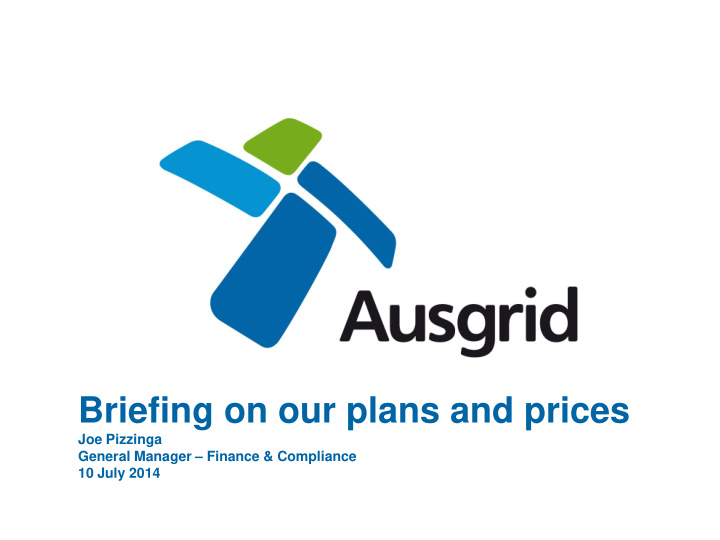



Briefing on our plans and prices Joe Pizzinga General Manager – Finance & Compliance 10 July 2014
Outline • Introduction to Ausgrid and our objectives • Our improving customer engagement • Our 5 year plans (revenue, capex and opex) • Typical bill impacts of our proposal over 5 years • Savings & efficiencies to date • Public lighting and metering services 2
Largest & oldest electricity network in Australia • Our network covers 22,275 square kilometers: – 30,000 substations – 48,000km of power lines and – 500,000 power poles • 1.6 million customers - households and businesses • 2.2 million meters • 250,000 street lights • Building our network today would cost an estimated $38 billion 3
Ausgrid’s objectives • Safety standards will be Number of Minutes per Outage per maintained or improved Customer (per annum) 120 100 80 • We will aim to maintain 60 SAIDI current average levels of 40 SAIDI Forecast 20 reliability performance while 0 making expenditure decisions based on a life-cycle view (20- 50 yrs) • Committed to keeping price rises below inflation through careful maintenance and investment planning 4
Consumer engagement strategy • A framework to understand and address consumer engagement • It follows best practice guidelines from AER based on IAPP – Provide information to customers, community and stakeholders – Consider feedback when making decisions – Report back on changes that have or have not been made. 5
What we have learnt so far Feedback received Reliability - Satisfied with reliability of power supply and network performance Prices - Strong views – continuing steep increases are not supported. Preference for stable prices. Incorporating this feedback Reliability - Maintain current levels of reliability reflected in network plans – 47% reduction in capital expenditure. Prices - Price increases below CPI for network part of electricity bills for next five years. 6
Our commitments for the next five years Revenue $11.8 billion Capital expenditure $4.9 billion, 47% real decrease $3.3 billion, 4% real increase Operating expenditure Real price reductions: Average network price increase remain below CPI 7
Capital expenditure ($m 13/14) $2,500M Capex was approx $1.8bn lower than the allowance over last period, which saves $51 p.a . in typical bill from 1 July 2014 $2,000M $1,500M $1,000M $500M $0M FY10 FY11 FY12 FY13 FY14 FY15 FY16 FY17 FY18 FY19 AER allowance Actual Forecast 8
Drivers for our forecast expenditure Capex $3,500m • Safety, reliability and $3,000m affordability $2,500m • Replacing old equipment at risk $2,000m of failure $1,500m • Customer connections – growth $1,000m • Supporting investments (IT, property, fleet, etc) $500m Opex $0m 2009-14 2014-19 • Maintenance to keep the network running Replacement Growth & new customers Support Maintenance 9
Our plans for the Sydney CBD and Inner West 10
Operating expenditure ($m, 13/14) 11
Operating cost drivers • Real cost of labour reflects EBA and industry forecasts as advised by independent consultants. • Increased demand management activities. • More inspections of private mains to ensure public safety. • Increased cost of vegetation management under contract. • Cessation of TSA services to EnergyAustralia. • Sale of head office requires leaseback for short transition period. • Upfront costs to restructure Ausgrid to deliver future savings. 12
We have made changes to reduce our costs • Better capital governance • Reduced non-essential spending – Travel, entertainment, sponsorship costs all significantly cut. • Fleet – reduction & extension of life • Overtime – cut by $70 million • Reduced the size of non- frontline workforce 13
Real decreases in network bills • Prices increased by an average 19.5% pa over the past five years • Small business should expect average price increases of 2.1% pa. • Largest customers have bills set on cost reflective basis but average price increase across all customers are expected to remain less than CPI. • We estimate prices in the next five years will increase by on average 2.37% pa – below CPI 14
Metering services • Newly classified by AER not a new service. Offset by reduction in network charges. • Accumulation metering price is our default service. • Time of use metering price – allows customers to opt in. • Incremental charge for secondary metering services such as metering for a solar panel. • Residual value charges to replace our meter before the end of its life. 15
Public lighting • The general public is satisfied with our lighting services. • New online outage reporting to help reduce outage times. • We know Councils have a range of concerns, including the complexity of pricing. • Small increase in opex charges to reflect higher actual repair costs experienced over the past 5 years. • Regulatory Proposal is a starting point and we will work with the AER to help implement simpler pricing. • Deliver public lighting promise to address service levels. 16
Be part of our ongoing conversation • Yoursay@ausgrid.com.au • Twitter • Facebook • Website • Community engagement report 17
Recommend
More recommend